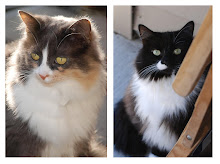
Oh no, not you dear readers, I would never refer to you as a bunch of suckers. I am, of course, referring to the subject of this post - the answer to Macro Mystery #3.
What we have here is an ochre starfish (Pisaster ochraceus), or sea star, if you prefer, since it is not a fish, but then a whale shark is not a whale and a jellyfish is not a fish, but that doesn't stop us from using their names, does it!?! Sorry, getting sidetracked by one of my pet peeves ........ back to the story - an ochre starfish chowing down on a mussel. But how on earth is it ever going to crack that hard shell, and there is no way that it could ever open one up, could it? Well, it doesn't have any thumbs, and I am pretty sure it does not have a knife to cut the mussel's strong muscles, does it?
 The evertible stomach. Yep, our spiny-skinned beauty has two stomachs, one of which it can extrude from its body and slip into the slightly cracked open shell of a bivlve, such as our unfortunate mussel here. Once the stomach is inside the shell, digestive enzymes are secreted, the contents of the shell broken down into a soupy liquid which is then drawn back into the starfish, along with its first stomach. Digestion can then be completed by the second stomach. I guess the starfish has to hope that it maintains its grip on the mussel, or it could be curtains for the evertible stomach!
The evertible stomach. Yep, our spiny-skinned beauty has two stomachs, one of which it can extrude from its body and slip into the slightly cracked open shell of a bivlve, such as our unfortunate mussel here. Once the stomach is inside the shell, digestive enzymes are secreted, the contents of the shell broken down into a soupy liquid which is then drawn back into the starfish, along with its first stomach. Digestion can then be completed by the second stomach. I guess the starfish has to hope that it maintains its grip on the mussel, or it could be curtains for the evertible stomach!Any interesting facts about the mussel? Not really. I am told that they can be very tasty, but I have a policy of not eating whole animals, including all the digestive tract, rectum, anus and all, so I wouldn't know about that. The golden brown threads that you can see around the hinge of the mussel is the byssus, or the "beard". The mussel squirts out these threads as a liquid, which it then coats in an organic varnish. The sticky threads attach the mussel to the rocks, so allowing it to live right on the edge of the rocky shore without being washed away by the crashing waves. These adhesive threads are very strong and are not degraded by salt or fresh water. They are so good at their job that scientists have now identified the genes that code for the proteins used to make the threads and inserted these genes into yeast, so that they can harvest the proteins by culturing the yeast. I don't think the yeast cells mind too much. Byssal threads from another bivlave, the Meditteranean pen shell, has such fine byssal threads that they can be woven into a very fine and much sought fabric known as sea silk. Rumour has it that this golden coloured silk may even be the famous Golden Fleece, as searched for by Jason and his Argonauts.
So, there you have it. The organisms are the orchre starfish, aka the purple starfish, which is obviously another stupid common name, since it is fairly evident from the photo below that many are in fact bright orange, and the mussel. One mark for each, half a mark for starfish. So I guess that means that most of you got half a mark for starfish, well done you, but Englishmum gets a full mark for getting the mussel! Well done - and no, this is not a case of nepotism, she really was the only one to get the mussel. A bonus mark goes to Jabblog for originality.










6 comments:
Isn't nature amazing. Although I do love mussels, slightly braised in the shell, garlic, white wine or plopped in tomatoey bouillabaise . .
Fascinating information and a new slant on the Golden Fleece.
I used to eat cockles, whelks, mussels until I looked closely one day and recognised what I was ingesting . . . never again!
(Thanks for the bonus mark ;-})
Starfish take 'dining out' very literally. Very interesting. Gorgeous photos again my dear.
I have always been fascinated by starfish and jellyfish as were my children when they were little.
But as for mussels with or without garlic - I think I'll leave that treat for Baino and the starfish of course!
Fascinating lesson here. I had never heard of the two stomachs.
Love mussels, though, digestive tract and all. Same for clams. Yum!
Baino: I knew all you would think about is eating them!
Jabblog: My Grandad used to eat periwinkles, hooking them out of their shells with a pin. I tried one once as a child and all I really remember is the salt and the gritty sand - bluergh! Oh, and you're welcome!
Carolina: Thank you, thank you.
Kate: I am with you there - Baino can have all the slimy, spineless aqautic creatures that she wants.
Suldog: I guess you will have to share them with Baino.
Post a Comment